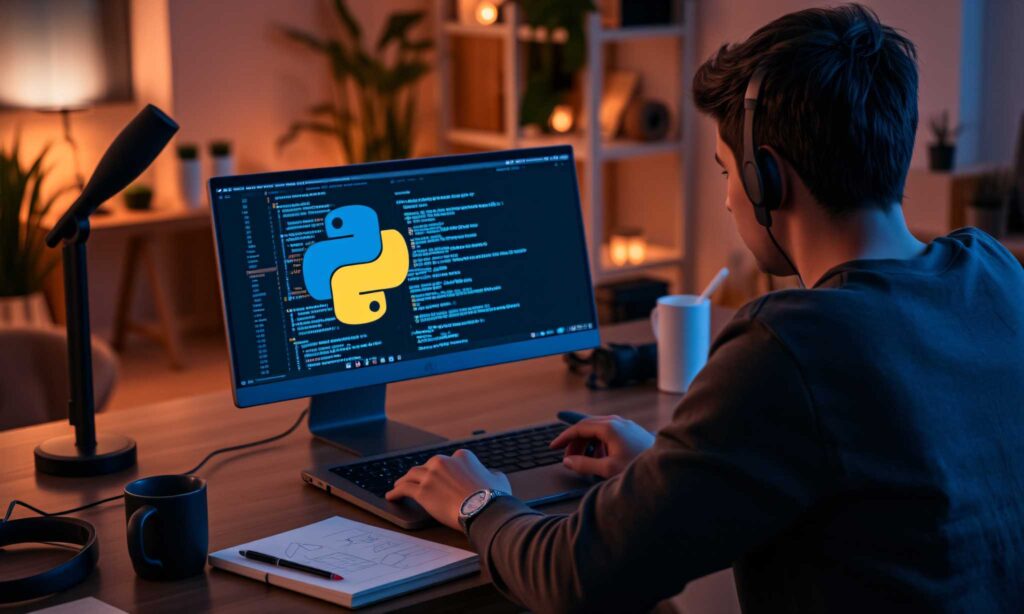When I first decided to learn programming, I remember feeling overwhelmed by all the different languages and frameworks out there. But then I found Python, and it completely changed my perspective on coding. Python has a reputation for being one of the most beginner-friendly languages, and I can personally vouch for it. If you’re thinking about diving into the world of tech, Python is an excellent choice to get started.
Why Python?
You’ve probably heard about Python, but why is it so widely recommended for beginners? Well, here are a few reasons:
- Simple Syntax: Python’s syntax is clean and easy to read, making it feel almost like English. You don’t have to worry about complex punctuation or rigid structure like in other languages.
- Versatility: From web development and data analysis to artificial intelligence and automation, Python is incredibly versatile. It’s used in a variety of fields, so learning it opens up many doors.
- Huge Community and Resources: The Python community is massive and supportive. There are tons of tutorials, forums, and open-source projects where you can learn and collaborate with others.
Step 1: Set Up Python on Your Computer
The first step to coding in Python is installing it. Luckily, Python is free, and setting it up is pretty straightforward. Head over to Python’s official website and download the latest version. If you’re using Windows, you can download the installer and make sure to check the box that says “Add Python to PATH” before clicking “Install Now.” On Mac and Linux, Python is usually pre-installed, but you can always update it to the latest version via the terminal.
Step 2: Get Familiar with an IDE or Text Editor
To write Python code, you’ll need a text editor or an integrated development environment (IDE). There are many choices out there, but here are a couple that I recommend:
- VS Code: A popular text editor with tons of features like syntax highlighting, code completion, and integrated terminal support.
- PyCharm: A full-fledged IDE specifically for Python, offering even more advanced features like debugging tools and project management.
You can start with something simple like VS Code, which is lightweight but still powerful enough for Python coding.
Step 3: Learn the Basics
Once you have Python installed and an editor set up, it’s time to start learning the basics. Here are a few fundamental concepts you should familiarize yourself with:
- Variables: These store data like numbers, text, or lists.
- Loops: Loops allow you to repeat tasks multiple times.
- Functions: Functions are reusable blocks of code that make your program more organized.
- Data Types: Learn about integers, strings, lists, and dictionaries.
The Python documentation is a great place to dive deeper into these concepts. If you’re looking for something more beginner-friendly, there are plenty of tutorials on YouTube and platforms like Codecademy or freeCodeCamp.

Step 4: Work on Simple Projects
Once you’ve learned the basics, it’s time to put your skills to the test. Start by building small projects. I remember creating a simple calculator in Python when I was just starting out. It was a simple program, but it helped me solidify my understanding of how Python works.
Here are a few beginner-friendly project ideas to get you started:
- Calculator: Create a program that can perform basic arithmetic operations.
- To-Do List: Build a simple to-do list app that allows users to add, remove, and view tasks.
- Number Guessing Game: Make a game where the computer randomly selects a number, and the user has to guess it.
Step 5: Keep Practicing and Challenge Yourself
The key to mastering Python—or any programming language—is consistency. Try to code a little bit every day. If you run into challenges, don’t get discouraged. There’s a whole community of Python developers who are there to help. Sites like Stack Overflow and Reddit’s Python community are great places to ask questions when you’re stuck.
Also, keep pushing yourself to take on more complex projects as you gain confidence. You’ll be amazed at how much you can learn by just tackling real-world problems.
Resources to Help You Along the Way:
- Python.org Documentation: https://docs.python.org/
- Codecademy’s Python Course: https://www.codecademy.com/learn/learn-python-3
- freeCodeCamp’s Python Tutorials: https://www.freecodecamp.org/news/learn-python-by-building-projects/
- Real Python: https://realpython.com/
Final Thoughts
Getting started with Python is an exciting journey, and I hope this guide gives you the confidence to take that first step. Remember, the key to learning programming is persistence. It’s okay to make mistakes—every coder does. The most important part is that you keep moving forward.
Are you ready to start coding in Python? Trust me, you’ve got this! Let me know how your learning journey goes. I’d love to hear about the projects you’re working on or any challenges you face. Happy coding!
